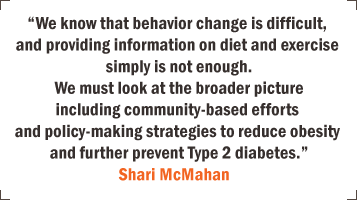Fighting Obesity Across the Border
Prevention Is Goal of Partnership with Mexican University and Health Care Agencies
April 1, 2008
by Mimi Ko Cruz
Two of every three people in Mexico are overweight or obese, and many of them die of diabetes or related diseases, according to a report by the Federacion Mexicana de Diabetes.
“The mortality rate is alarming, and we need to do what we can to combat obesity,” said Silas H. Abrego, associate vice president for student affairs and the principal investigator for Cal State Fullerton’s obesity prevention program that partners CSUF with the Universidad Autónoma de Tlaxcala in Mexico and various U.S. and Mexican health agencies and hospitals.
The partnership is one of 10 that the federal government, through the U.S. Agency for International Development (USAID), established as part of the Training, Internships, Exchanges and Scholarships (TIES) program.
The goal is to address the surge in Type 2 diabetes (the most common form of diabetes) by evaluating lifestyles in Tlaxcala; increasing understanding of sociologic and economic perspectives influencing primary and secondary health care; and designing a program to empower Tlaxcalans to prevent obesity by maintaining healthful lifestyles, said Christine L. Latham, professor of nursing and the project’s director.
Tlaxcala is the smallest state in Mexico, with a population of less than 2 million, yet more people die of diabetes and related diseases there (16.4 percent) than in any other state in Mexico, according to Mexican government statistics.

Latham said the USAID-TIES project includes research and student and faculty exchanges. It also includes a certificate in public health with a focus on diabetes prevention that is being designed by Latham; Abrego; Victor M. Rojas Jr., project manager of special programs on campus; and Shari McMahan, chair and professor of health science and director of the Center for the Promotion of Healthy Lifestyles and Obesity Prevention.
An advisory committee, made up of representatives from community health care organizations, is providing program input and evaluation.
In addition to several faculty exchanges, two Cal State Fullerton nursing students went to Tlaxcala last May, and a dozen graduate nursing students and a public health student will go in June. While there, the students learn about that state’s health care system and the nursing program at the Universidad Autónoma de Tlaxcala.
“We are anticipating 12 Tlaxcalan students, faculty and Department of Health representatives will visit Fullerton in June,” Latham said. “They will be completing the certificate program, which includes a number of community-based activities.”
The Tlaxcalan students who will be visiting “will develop a culturally relevant diabetes and obesity prevention model that they can they take back to Tlaxcala and implement at the individual, community, workplace and/or policy level,” Rojas said.
In turn, the project “allows our public health and nursing students to gain valuable hands-on experience in a country where language and culture are completely different than our own,” Rojas said. “The experiences they bring back with them from Mexico allow them to better understand the needs of patients in their communities and make them better practitioners.”
The USAID-TIES project, Abrego said, “is very important because obesity is a serious problem here and abroad.”
Indeed it is, according the U.S. Centers for Disease Control. The CDC reports the following:
- In 2002, 8.2 million, or 6.3 percent, of the people in the United States had diabetes.
- In 2000, diabetes was the sixth leading cause of death listed on U.S. death certificates
- About 40 percent (41 million people) of U.S. adults, ages 40 to 74, have pre-diabetes, a condition in which blood glucose levels are higher than normal but not high enough for a diagnosis of diabetes.
- People aged 65 or older account for nearly 40 percent of the population with diabetes.
- As obesity rates in children continue to soar, Type 2 diabetes is becoming more common in young people. About 150,000 school-aged children and adolescents have diabetes.
- The percentage of women considered obese spiked 160 percent between 1988 and 1999.
- In 2000, about 60 percent of men and 64 percent of women were overweight or obese.
- In 2002, a government study in Mexico City found that 30 percent of elementary school children and 45 percent of adolescents were overweight or obese.
- Obesity has created a spike in diabetes, which now is the leading cause of death among adults. Eleven percent of Mexican adults have diabetes.
Diabetes, if not treated, can lead to serious health problems and cause blindness, lower limb amputations, kidney failure, heart disease and stroke, public health care officials report.
“This project ties right into our efforts to prevent diabetes and obesity in the community,” McMahan said. “What’s exciting is that we are using a social ecological model of obesity prevention and training the Tlaxcalan students to use components of this model in their home country. We know that behavioral change is difficult, and providing information on diet and exercise simply is not enough. We must look at the broader picture, including community-based efforts and policy-making strategies to reduce obesity and further prevent Type 2 diabetes.”

